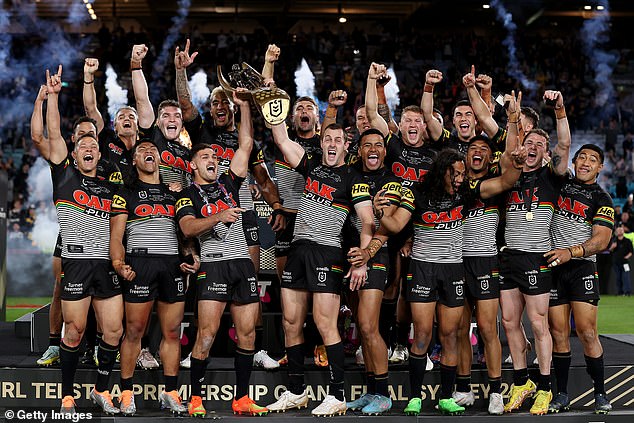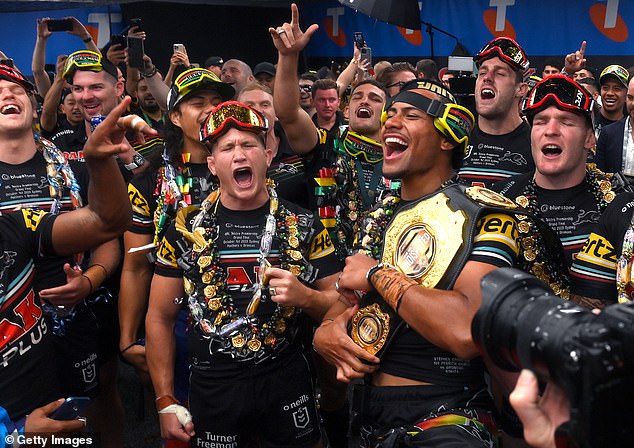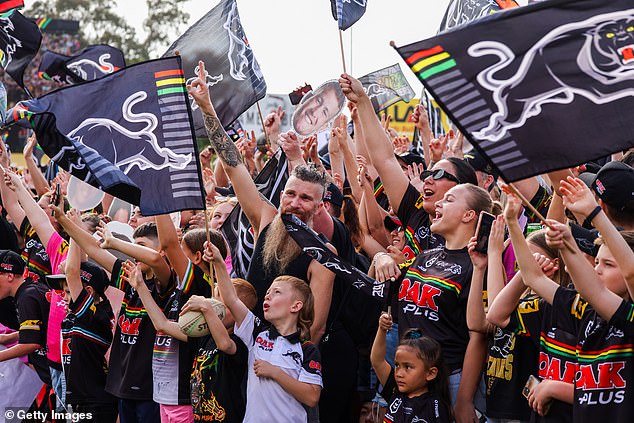The secret document from 2011 that paved the way for Penrith Panthers NRL dynasty that could extend to FOUR premierships
An 18-page dynasty dossier from 2011, with lessons learned from an AFL powerhouse and global sport, is the driving force behind the most successful NRL club of this century.
The ‘Project 2015′ document, first presented to Rugby League Penrith CEO Matt Cameron 13 years ago by Phil Gould, remains at the heart of the Panthers’ success to this day.
AAP has been given exclusive access to the pages that turned Penrith into a juggernaut as they battle to become the first team in almost 60 years to win four consecutive premierships in Sunday’s grand final against Melbourne.
At its core, the plan outlined what needs to happen at Penrith in 2015 to make the club successful over the next decade.
On the opening page it is presented as a ‘strategy for future-proofing long-term athlete development pathways and management, aimed at continued, sustainable success’.
It also provided a plan around coaching structure, high performance, recruitment and retention, along with centralized coaching for junior development.
Concerns are also being raised about clubs moving in two to three year cycles without ‘thinking about the bigger picture’, and there is a goal to remedy that.
They were words that woke a sleeping giant and provided a platform for success that would withstand anything rival clubs (and their recruiters) would throw at Penrith.
Nathan Cleary and the Penrith Panthers will compete for a fifth consecutive NRL grand final
“It was all about coordination,” Cameron told AAP.
“About getting the coaches in a room and saying, ‘Ivan, tell us what you’re looking for in a first division player.’
“Then let’s break it down into consecutive pieces so the 16-year-old boy can coach that and the 18-year-old boys can coach that.”
The idea, which had been in the making for years, first emerged from a conversation between Cameron and West Coast Eagles development manager Peter Worsfold in 2009.
“(Peter) said they decided that whatever decision they made at the club would apply in 10 years,” Cameron recalled.
‘Let’s stop thinking in terms of contract cycles and looking after ourselves, and let’s build a club from within.’
The overhaul came quickly, with Penrith taking a long-term approach that extended beyond the contract cycles of coaches and players.
The NSW Cup was brought back from Windsor, while the number of junior academies increased under the document’s plans for a ‘more rigorous internal scouting network within the Penrith district’.
The junior program was streamlined, with dedicated staff and the likes of Lee Hopkins employed full-time as junior strength and conditioning coach.

The success began in 2021 when Cleary and junior product Jarome Luai steered the Panthers to the first of their three consecutive Grand Finals
A junior elite training program was also established, with Jarome Luai among the freshmen.
“In the run-up to that Project 2015 document, I think Penrith forgot who they were,” said Hopkins, who had worked part-time at Penrith since 2010.
“As an organization, we forgot that every time we had success, it was through the local kids who came through our system.
‘We had the largest junior competition in the world at our disposal, but we didn’t take advantage of it.’
Determined to make Penrith a club built on their own junior talent, programs were streamlined and regular meetings took place between NRL staff and those overseeing the juniors.
“I always said to people, if the NRL doesn’t do it, we don’t do it,” Hopkins said.
‘Because it’s of no use.
‘Everything is layered. Harold Matts (under 17 years old) gets 25 percent of the NRL program.
“(Under-19s) SG Ball gets 50 per cent of it, the (under-21s) Jersey Flegg gets 75 per cent, NSW Cup gets 95 per cent and the NRL 100 per cent.”

The elite and junior pathways programs allowed the Panthers to remain the benchmark of the league even as players left for other clubs
Cameron and recruitment manager Jim Jones initially led the elite path room, with the filing stating that Penrith ‘should be able to develop, identify and retain the best players within its district’.
Satellite sites were soon set up in Dubbo, Forbes and Bathurst, after it became clear that Penrith was not tapping into a potential gold mine.
Regional players learned the same skills and structures as those in Penrith, being hired for under-17 matches on Friday evenings before moving to the district later in life.
Former halfback Ben Harden later took over the trails and is now Hopkins’ baby, with Jones’ son Sam also taking over identification and scouting.
“Everything was very streamlined, what they used in first grade was used everywhere,” said former under-18s coach Alex Chan.
‘From work ethic to terminology.
“You can see it now, when 18-year-olds are making their debuts in the NRL for Penrith. They’ve gone up a grade, but they’re never shocked.”

However much the club’s depth was tested, it remained at the top of the NRL
Recruiting at the highest level also became a focus, with an eye on models used in the NFL, as the club adopted a long-term whiteboard magnet concept to balance maintaining top performance with room for emerging talent.
It was in this sense that James Maloney and James Tamou were signed, then let go for the emergence of Luai and young strikers.
“Project 2015 would include the development and implementation of a recruitment and retention model that would include the NRL, (under 20s), NSW and (Queensland) Cups, Matts and Ball,” the document said.
‘The model would be designed with annual projections in mind and would allow staff to visualize future teams with both contracted and targeted players.
“(It) would be based on methodologies used by some of the leading NFL clubs.”
By 2014, the turnaround had begun.
Penrith reached their first preliminary final in a decade with a team that in their formative years included Isaah Yeo, Matt Moylan and Bryce Cartwright.

Fans hope the case will bring even more success for the Panthers in the future
The Panthers also won the NSW Cup, but more importantly Luai, Nathan Cleary, Dylan Edwards and James Fisher-Harris began to dominate the junior competitions.
And the likes of Stephen Crichton and Spencer Leniu were yet to come as Penrith went from regular finalists to their first major final in 2020.
“They won a lot of games in the Matts and Ball era, and by the 20s you really started to see the success of what could happen,” Hopkins said.
‘Everyone talks about skills, but learning to win is a set of skills. Learning to win and do those kinds of things is a skill set. Those kids never really lost games.”
Come Sunday’s grand final, as many as 14 of Penrith’s 18-strong group of juniors will have played for the club.
“That document was moving in everything we did,” Hopkins said.
‘My position now is that I still do things that are in that document today. I still watch it.
‘We trust the system. Every individual involved in this organization relies on the system built in the Project 2015 document.
“If it hadn’t been produced, I’m not sure where anything would be in this organization right now.”
